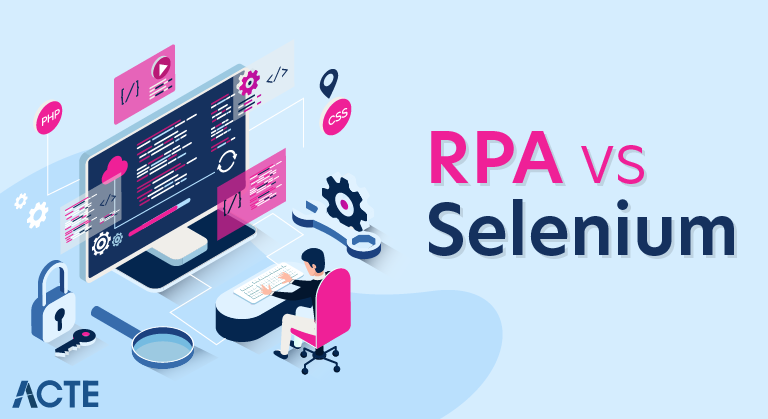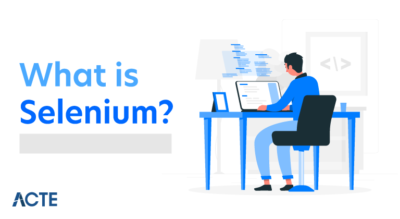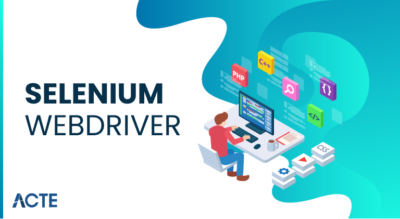
Technology, in recent days, has reached the peaks and the growth of automation has added more wings to this transformation. From automating a simple unit test to automating the whole business process, technology has augmented its way to the digital era. In this Selenium vs RPA blog, I will give you a lucid idea of how these automation tools differ from one another.
- According to house of bots, the market of RPA is estimated to reach $2.46 billion by 2022, at a CAGR of 30.14% between 2017 and 2022. This is directly proportional to the people trying to build a career in RPA.
- According to prnewswire, the global automation testing market size is expected to grow from USD 8.52 billion in 2018 to USD 19.27 billion by 2023, at a CAGR of 17.7% during the forecast period. Selenium is one of the most used automation testing tools.
What is Selenium?
Selenium is an open source portable framework for automating web applications testing across different browsers (Chrome, Firefox, Safari) and not just the traditional browsers.
- WebDriver
- Selenium Grid
- Selenium Remote Control(RC)
- Selenium Integrated Development Environment (IDE)
Its features :
- Selenium supports cross-browser testing which makes the implementation of the test-cases easy across various browsers multiple times.
- Test cases can be written in several programming languages such as Java, Python, C#, Ruby, etc. Among these, Java is the most commonly used language to write test scripts.
- Selenium is highly flexible when it comes to functional and regression testing. Functional testing helps to test the software against the business requirement and ensures there are no defects. Regression testing helps in re-executing the tests against the modified application to checks whether the modified code runs accordingly.
- A set of Selenium commands that run tests are called Selenese, and test script refers to the sequence of these commands.
- Tests cannot be performed on mobile or desktop applications; it is solely prone to web application testing.
What is RPA ?
Robotic Process Automation (RPA) is a business automation technology that helps in automating the humdrum repetitive tasks (data entry, banking) without human intervention.
Its features:
- RPA was coined with the vision of empowering business users to create software bots (robots) that could interact with the system just like humans.
- It evolved from the three key predecessors: Screen scraping, workflow automation, and artificial intelligence.
- RPA bots are powerful to mimic several human actions such as log into applications, copy and paste data, move files and folders, fill in forms, scrape browsers and extract structured & semi-structured data from documents.
- It is highly dependent on Screen scraping & Workflow automation that manages workflows using drag & drop features in a visual way, which is entirely independent of coding knowledge.
- RPA is basically a combination of Artificial Intelligence and automation.
- RPA is platform independent.
Robotic Process Automation:
RPA stands for Robotic Process Automation. It is an automation technology which helps to automate the repetitive tasks without the intervention of humans. RPA was formed with the perception of authorizing business users for making software bots which is able to interact with a system like a human. RPA came into the business from 3 main predecessors namely,
- Screen Scraping
- Workflow automation
- Artificial intelligence
- Screen scraping tools play a major role in data migration and integration. The first technology that created a bridge between the current system and the legacy systems. It is a component used for collecting screen display data from one application, and translating it so that another application can display it. It offers functionalities to retrieve the data by scraping the user interface of other applications.
- Workflow Automation refers to the automation and execution of a business process where tasks are performed based on a set of procedural rules. This helps in designing low code workflows, executing them with less effort, managing everything and optimizing the workflow for a better outcome.
- Artificial Intelligence is a completely different concept. It mainly deals with the simulation of human intelligence by machines. It lets your system do all the assigned tasks that the user was supposed to do. AI has the ability to transform the industry and help in business development. Machine learning and Deep learning are a few ways to implement AI.
The following features help in better understanding of RPA:
- Software bots have emerged as a potential way for organizations to achieve clear cost savings.
- For the tasks that require repetitive execution of programs, RPA would be the best option.
- It helps in the business processes like operational activities, calculations and data extraction in various organizations
- You can get a more accurate result in less time because it is easy to learn and implement.
- The number of errors is reduced.
- RPA can be used as a link to external systems that cannot be connected via other IT options.
- Security comes into action when you talk about business process automation. The data that the user will be working on will be highly protected and the risk factor reduces.
Comparison of Selenium and RPA :
I will consider the following factors to compare Selenium vs RPA.
What do these tools automate?
Selenium automates testing of web applications. Robotic Process Automation (RPA) automates business processes such as maintenance of records, queries, transaction processing, calculation and so on.
Where does the automation take place?
Selenium can automate only the current web page. RPA automates all the backend processes that are time-consuming.
Are these tools open-source or paid?
- Selenium is an open-source testing tool whereas RPA tools are UiPath, Automation Anywhere, BluePrism and others.
- Among these tools, UiPath offers a platform to learn, where the community edition is free for individual use and the business edition is licensed. The other tools are for business use and are licensed.
Which major component is used by Selenium and RPA?
- Webdriver plays a very important role in automating the test cases because it overcomes all the disadvantages of Selenium RC and makes the testing process simple and clear.
- RPA makes use of bots that help in rendering possible outcome by imitating human activities.
What is the level of automation in these tools?
- RPA helps in maintaining huge records of data and simplify the process and it is flexible in dealing with the clerical processes.
- Selenium does not support the clerical processes taking place because it works on the front end of the web application.
Robotic Process Automation Life Cycle :
- Analysis
- Bot Development
- Testing, and
- Support & Maintenance
Step 1: Analysis
The life cycle in RPA begins with Analysis.
- The business team works together to identify the process of RPA development.
- It helps to identify processes that are feasible for automation.
- Planning the development process with the help of resources. Then the process is formulated with an RPA lead.
- A documental approach is approved by the stakeholders after it is completed.
Step 2: Bot Development
- The bot development process takes place in a separate environment.
- Limited coding is required because it is a Wizard-driven process.
Step 3: Testing
Testing is carried out in two ways:
- RPA development testing
- Separate testing tool
Among these, RPA development testing is preferred because script correctness is verified and reviewed. Whereas, by using a separate tool, testing can be performed on a dedicated QA environment.
Step 4: Support and Maintenance
After the development and testing, it enters the Maintenance phase. Every change is updated at regular intervals. If there is an error, the process is tested and repeated continuously for a better outcome.
Selenium Life Cycle :
- Test plan
- Generating basic tests
- Enhancing tests
- Running and Debugging tests
- Analyzing test ults and Reporting defects
Step 1: Test Plan
- Get the application environment specifications from the development team.
- Then, identify the objects in the AUT(Application Under Test).
- Further, create the test cases.
- At last, select the appropriate framework based on the requirements.
Step 2: Generate Basic Tests
- Selenium IDE: Element locator & selenese commands.
- Selenium WebDriver: Element locator techniques & WebDriver methods are used.
Step 3: Enhancing Testing
- Insert a validation point using Assert/Verify commands.
- Synchronization with the application being tested.
- Handling expected & unexpected errors.
Step 4: Running and Debugging Tests
- Executing a test case is an important phase in the Selenium life cycle.
- Debugging is required only if there is an error in the test case.
Step 5: Analyse Results and Report Defects
- Selenium helps in giving the overview of the records and does not provide detailed reports.
- TestNG and JUnit is used to generate detailed records.
Selenium vs RPA: Similarities between these tools
- Both Selenium and RPA are automation tools that reduce manual intervention and enhance quality.
- Both of them follow the Rule-based process.
Comparison of RPA & Selenium :
| parameter | Selenium | RPA |
|---|---|---|
| Automation | Automates Browser Applications | Automates Business Processes |
| Availability | Open Source |
|
| Where is the Task Performed? | On the Current Browser Page | At the Backend of the Process |
| Major Component Used | Selenium Web Drivers | RPA Bots |
| Level of Automation | No Clerical Process | Low-value Clerical Process |
| Life Cycle | Relatively Difficult | Simple and Easy |
| Platform Dependency | Browser Platform Dependent | Platform Independent |





